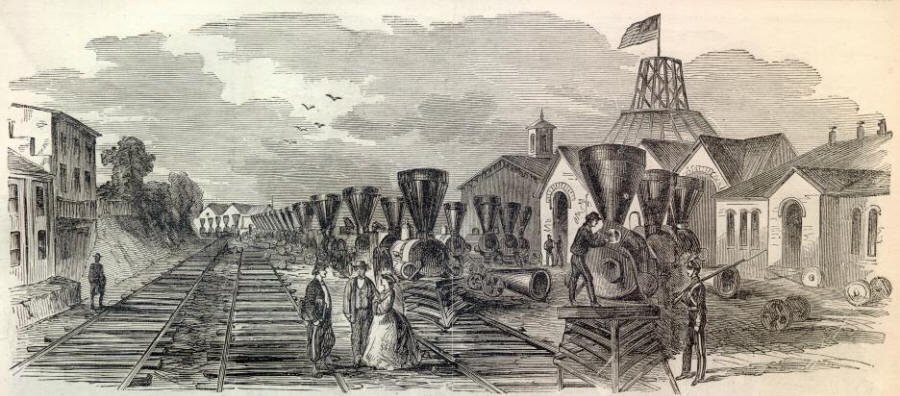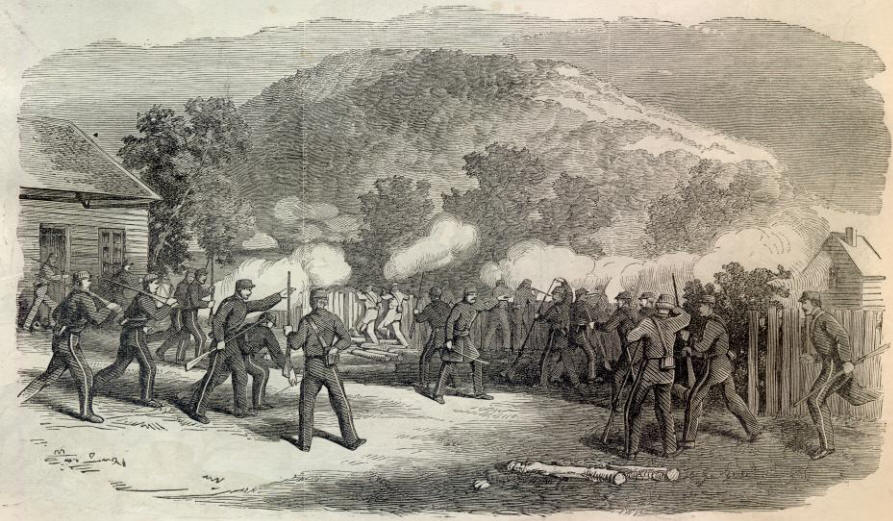The Battle of Bull Run (original) (raw)
This Site:
| **Civil War Harper's Weekly, August 3, 1861 This Civil War Harper's Weekly newspaper describes a number of important events of the war. It includes eye-witness illustrations of the events, and important news of the day. It also has first edition coverage of the Battle of Bull Run. (Scroll Down to see the entire newspaper page, or Newspaper Thumbnails below will take you to a specific page of interest) | |||||||
|---|---|---|---|---|---|---|---|
| **Civil War Harper's Weekly, August 3, 1861 | |||||||
 The Battle of Laurel Hill The Battle of Laurel Hill |
 Editorial Editorial |
 Early Report on Battle of Bull Run Early Report on Battle of Bull Run |
 Bull Run Battle Map Bull Run Battle Map |
 Tillman and the Waring Tillman and the Waring |
 General George McClellan Biography General George McClellan Biography |
 Rowlesburg, West Virginia Rowlesburg, West Virginia |
 The Battle of Bull Run The Battle of Bull Run |
 The Battle of Carthage, Missouri The Battle of Carthage, Missouri |
 Winchester, Virginia Winchester, Virginia |
 Start of the Battle of Bull Run Start of the Battle of Bull Run |
 Civil War Weapons Civil War Weapons |
 Battle of Bull Run Cartoon Battle of Bull Run Cartoon |
|||
 Hunter's Charge at the Battle of Bull Run Hunter's Charge at the Battle of Bull Run |
**DESTRUCTION OF LOCOMOTIVES
AT MARTINSBURG, VA.
ON this page we illustrate one of the effects of the Southern Rebellion�the destruction of valuable property by the rebels. Our special artist writes us from Martinsburg: " The destruction of locomotives, cars, etc., by the Confederates is one of the most disgraceful sights I ever witnessed. Forty-two as fine engines as could be built have been mutilated, some by burning, others by mere destruction with hammers and crow-bars. The stationary engine has met with no better treatment, and the buildings themselves were only saved from destruction by the precipitate flight of the Confederate troops."
**SKIRMISH ON THE POTOMAC.
SKIRMISHING along the Potomac has become an everyday amusement with the troops stationed on the upper part of that river. Scarcely a day passes without an exchange of shots at some point between Edwards Ferry and Sandy Hook. Both parties generally keep themselves sheltered behind the trees and rocks that line the shores. So far two of the Federal troops have been killed and three wounded. It is not known how many have lost their lives on the other side. Several have been seen to fall. This sketch represents a little brush which took place at Sandy Hook a few days ago. After some pretty sharp firing, in which nobody was hurt, the Virginians retreated into the mountains, and hostilities were suspended.
**THE BATTLE AT BULL'S RUN.
WE devote a considerable portion of our space this week to the illustration of the BATTLE OF BULL'S Run. A large view of COLONEL HUNTER'S ATTACK, from sketches by our special artist, who was present, will be found on pages 488 and 489; the COMMENCEMENT OF THE FIRING is illustrated on page 492; and on the same page will be found an illustration of the cautious EXPLORING OF THE GROUND by our artillery. On page 484 will be found a MAP of the battle. We give the following account from a letter addressed by Mr. Henry J. Raymond to the Times :
On Saturday the troops were all brought closely up to Centreville, and all needful preparations were made for the attack which was intended for the next day. On Sunday morning, therefore, the army marched�by two roads �Colonel Richardson with his command taking the Southern, which leads to Bull's Run, and General Tyler the Northern, running parallel to it at a distance of about a mile and a half. The movement commenced at about 3 o'clock. I got up at a little before 4, and found the long line of troops extended far out on either road. I took the road by which Colonel Hunter with his command, and General McDowell and staff had gone, and pushed on directly for the front. After going out about two miles Colonel Hunter turned to the right�marching obliquely toward the Run, which he was to cross some four miles higher up, and then come down upon the intrenched positions of the enemy on the other side. Colonel Miles was left at Centreville and on the road, with reserves which he was to bring up whenever they might be needed. General Tyler went directly forward, to engage the enemy in front, and send reinforcements to Colonel Hunter whenever it should be seen that he was engaged.
I went out, as I have already stated, upon what is marked as the northern road. It is hilly, like all the surface of this section. After going out about three miles you come to a point down which the road, leading through a forest, descends; then it proceeds by a succession of rising and falling knolls for a quarter of a mile, when it
crosses a stone bridge and then ascends by a steady slope to the heights beyond. At the top of that slope the rebels had planted heavy batteries, and the woods below were filled with their troops and with concealed cannon. We proceeded down the road to the first of the small knolls mentioned, when the whole column halted. The 30-pounder Parrott gun, which has a longer range than any other in the army, was planted directly in the road. Captain Ayres's battery was stationed in the woods a little to the right. The First Ohio and Second New York Regiments were thrown into the woods in advance on the left. The Sixty-ninth, New York, the First, Second, and Third Connecticut regiments, were ranged behind them, and the Second Wisconsin was thrown into the woods on the right. At about half past six o'clock the 30-pounder threw two shells directly into the battery at the summit of the slope, on the opposite height, one of which, as I learned afterward, struck and exploded directly in the midst of the battery, and occasioned the utmost havoc and confusion. After about half an hour Captain Ayres threw ten or fifteen shot and shell from his battery into the same place. But both failed to elicit any reply. Men could be seen moving about the opposite slope, but the batteries were silent. An hour or so afterward we heard three or four heavy guns from Colonel Richardson's column at Bull's Run, and these were continued at intervals for two or three hours, but they were not answered, even by a single gun.
At half past 11 we heard Hunter's guns on the opposite height, over a mile to the right. He was answered by batteries there, and then followed the sharp, rattling volleys of musketry, as their infantry became engaged. The firing was now incessant. Hunter had come upon them suddenly, and formed his line of battle in an open field, at the right of the road. The enemy drew up to oppose him, but he speedily drove them to retreat and followed them up with the greatest vigor and rapidity. Meantime, for some three hours previous, we had seen long lines of dense dust rising from the roads leading from Manassas, and, with the glass, we could very clearly perceive that they were raised by the constant and steady stream of reinforcements, which continued to pour in nearly the whole day.
The Sixty-ninth, Seventy-ninth, Second, and Eighth New York�the First, Second, and Third Connecticut, and the Second Wisconsin were brought forward in advance of the wood and marched across the field to the right to go to Colonel Hunter's support. They crossed the intervening
stream and drew up in a small open field, separated front Colonel Hunter's column by a dense wood, which was filled with batteries and infantry. Our guns continued to play upon the woods which thus concealed the enemy, and aided materially in clearing them for the advance. Going down to the extreme front of the column, I could watch the progress of Colonel Hunter, marked by the constant roar of artillery and the roll of musketry, as he pushed the rebels back from point to point. At 1 o'clock he had driven them out of the woods and across the road, which was the prolongation of that on which we stood. Here by the side of their batteries, the rebels made a stand. They planted their flag directly in the road, and twice charged across it upon our men, but without moving them an inch. They were met by a destructive fire, and were compelled to fall still further back. Gradually the point of fire passed further away until the dense clouds of smoke which marked the progress of the combat were at least half a mile to the left of what had been the centra1 position of the rebels.
It was now 2 o'clock. I was at the advanced point of the front of our column, some hundred rods beyond the woods, in which the few troops then there were drawn up, when I decided to drive back to the town for the purpose of sending you my dispatch. As I passed up the road the balls and shell from the enemy began to fall with more than usual rapidity. I did not see the point from which they came; but meeting Captain Ayres, he said he was about to bring up his battery, supported by the Ohio Brigade, under General Schenck to repel a rumored attempt of cavalry to outflank this column. As I went forward he passed down. General Schenck's Brigade was at once drawn up across the road, and Captain Ayres's guns were planted in a knoll at the left, when a powerful body of rebels, with a heavy battery, came down from the direction of Bull's Run, and engaged this force with tremendous effect. I went to Centreville, sent off my dispatch, and started with all speed to return�intending to go with our troops upon what had been the hotly contested field, never doubting for a moment that it would remain in their hands. I had gone but a quarter of a mile when we met a great number of fugitives, and our carriage soon became entangled in a mass of baggage-wagons, the officer in charge of which told me it was useless to go in that direction, as our troops were retreating. Not crediting the story, which was utterly inconsistent with what I had seen but a little while (Continuation ofBull Run Battle)
SKIRMISH BETWEEN A PORTION OF THE NINTH AND CONFEDERATE TROOPS ACROSS THE RIVER AT SANDY HOOK

